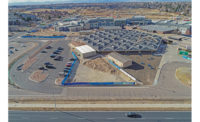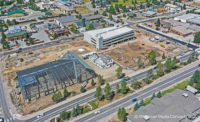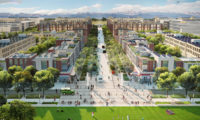Innovative, technology-driven communities are being designed and constructed for the next generation—and beyond. Although each of them is uniquely planned, experts say the central theme of connectivity is the key to turning concepts into reality.
“While the term ‘smart city’ has been out in the general public for about a decade, if you poll people, everyone has a different definition,” says Marty Skolnick, account manager for intelligently integrated development with Siemens. The firm is the technology partner helping to build Sterling Ranch, a master-planned smart community southwest of Denver.
Acknowledging that the term is nebulous, Skolnick says, “Fundamentally, it can’t be smart unless it’s connected,” referring to the underlying infrastructure that allows technology to do its job.
“That infrastructure could be the fiber-optic network, high-density wireless and so on. But more importantly, it will determine how all the devices connected will communicate with one another,” allowing end-users to employ the technology for their individual needs, Skolnick notes.
Siemens and its strategic project partners—general contractor Mortenson, fiber infrastructure owner Lumiere and fiber system designer IBM—have broken ground on the first filing of 800 homes at Sterling Ranch, with 12,000 homes planned over the next two decades.
The community is partnering with Century Link to deliver 1 gigabyte of internet speed to every door in the neighborhood. Further, every home will be prewired for solar power and electric-car charging as well as submetered and ready for next-generation “time-of-use rates,” which will allow utilities to offer customers lower pricing for energy usage during off-peak hours.
A Bold Move
“To [claim] you’re building a smart city is a bold thing to say,” says Mike Beehler, engineer and vice president at Burns & McDonnell’s Kansas City headquarters. He says a true smart city is a municipal environment that connects the basic infrastructure of diverse neighborhoods and communities to drive operational excellence, revenue potential and sustainable lifestyles.
In December 2015, the U.S. Dept. of Transportation launched its “Smart City Challenge,” which asked midsized U.S. cities to employ smart-mobility solutions. Seventy-eight cities applied, including Denver. Peña Station Next, the 384-acre transit-oriented development being built near Denver International Airport, is a test arena for several innovative technologies, says George Karayannis, vice president of CityNow, the smart-city arm of Panasonic Enterprise Solutions Co. It is a key member in a public-private partnership that also includes the city of Denver, DIA and developer L.C. Fulenwider Inc.
Peña Station Next is piloting the use of a driverless shuttle to connect commuters from an adjacent light-rail stop to nearby hotels and businesses. It also features Colorado’s first microgrid, a public-private project with Xcel Energy. Modeled after Fujisawa, the Japanese smart town built on the site of an old Panasonic factory, Peña Station Next is touted as a living lab for testing technologies such as LED street lights, smart parking, environmental sensoring, interactive and digital signage, and other components. Still early in its development, the mixed-use community will run on solar power during the day and stored battery power when off the grid.
“In phase one, we have created one of the smartest and most sustainable developments in the world,” Karayannis says. Panasonic opened Peña Station Next’s anchor-tenant office building in September; the first vertical construction project to be built in the neighborhood, it serves as the technology and operations hub.
“If you follow a business-as-usual approach, then you’ll end up with business-as-usual results,” Karayannis says. “What we’re creating are truly transformative cities with a ‘system of systems’ approach. For example, if you don’t plan your underground infrastructure right from the beginning, it becomes too expensive to go back.”
Smart Corridors
Planning and engineering firm VHB, Orlando, Fla., is helping the city of Orlando to move forward with smart-mobility concepts, focused on energy efficiencies such as LED street lights, alternative fuels and solar-generating parking garages. “Interconnectivity is key for moving from auto-centric thinking to the implementation of smart corridors,” says David Mullholland, VHB Southeast regional manager. “While there are a lot of initiatives for moving people smarter—not just widening roadways—we will also see a movement toward utilizing the advanced technology that contractors can provide.”
Smart-city concepts will provide the industry’s more sophisticated contractors and designers an opportunity to differentiate themselves because of the complexity of the infrastructure, says Gene Hodge, vice president of project development for Mortenson, the infrastructure contractor at Sterling Ranch and vertical builder of the Panasonic building at Peña Station Next.
“The up-front capital investment is typically a little bit higher as well, which of course is intended to be paid back in savings over the life of the development,” Hodge says. “More up-front capital investment means larger projects and larger revenues for contractors and designers.”
“As we start to employ these more and more complex technologies,” adds Beehler, “we will need really educated, innovative engineers and contractors who understand how to deploy this new technology on legacy systems or [develop] brand-new, state-of-the-art technology on greenfield communities.”
Beehler and other experts insist that success for firms building smart cities will depend on rethinking traditional contracts; creating technology partnerships with developers, contractors and engineers; and understanding that the lowest-cost building concepts will not achieve smart-city goals.
Skolnick offers further advice to contractors, saying, “Don’t venture into a connected or smart project without a technology partner and adapt your expertise to the changing workforce of the future. Focus on what’s happening five and 10 years from now [particularly with your workforce], and you’ll systematically be able to employ what’s right from a technology standpoint.”
Adds Skolnick, “The future of design and construction will demand the ability to provide this connectivity.”








Post a comment to this article
Report Abusive Comment